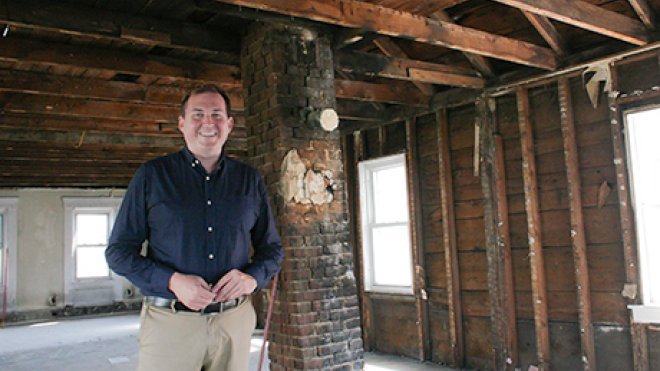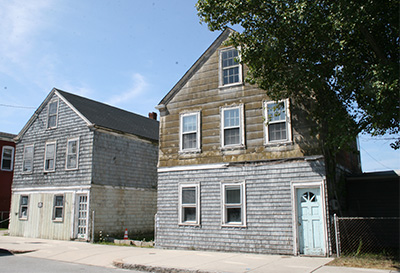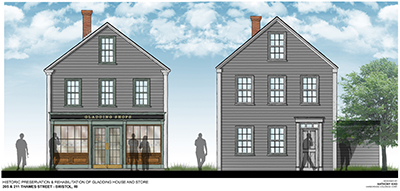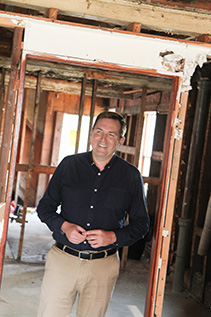Meet Ben Bergenholtz: The Entrepreneurial Preservationist
With a bachelor’s and master’s in preservation studies from RWU, the alumnus has built a business of bringing historic buildings back to life

BRISTOL, R.I. – The Town of Bristol recently faced an investment impasse. It had purchased prime waterfront property with the intent of demolishing two dilapidated buildings and improving public access to scenic harbor views. But that plan went awry when a state historic commission declared the mid-1800s structures had to be preserved.
The town had already invested $450,000 into buying the property, but didn’t have another estimated $1 million to restore the former Gladding Tin Shop and import goods store at 205 and 211 Thames St., both vacant for the past five years. That’s when town officials turned to Harborside Holdings Corporation and principal owner Benjamin Bergenholtz ’03 ’12M, a historic preservation expert and real estate developer who specializes in breathing new life into run-down historic buildings.
“These buildings are some of the last small-scale shops left from Bristol’s waterfront trade during that era and, once fully restored, will give you a sense of what Bristol’s harbor district looked like during the mid-19th century and earlier,” Bergenholtz says. “This project will contribute to beautifying the streetscape and tell the story of Bristol’s downtown historic district.”
Through a public-private partnership, Bergenholtz’s company will invest in creating mixed-use residential and commercial space while restoring the buildings to their original character. The property features an 1855 New England-style post-and-beam, and the adjacent balloon-framed timber structure added a decade later, both built by John Gladding, a tinsmith who forged metalwork on the first floor and lived above his shop and sold imported retail goods in the other building.

After stripping the contemporary finishes added over the centuries, Bergenholtz has identified several defining architectural details like the original storefront window frames to both buildings and the chamfer decorative touch where post meets beam. In other places, he’ll bring back characteristic elements such as the square-paneled tin roofs that originally enclosed both buildings and the corner posts that had “anchored” the exteriors.
“We think this will add authenticity and character to the area and preserve the history of these buildings,” says Bristol Town Administrator Steven Contente, who received his bachelor’s and master’s in criminal justice from RWU. “We feel this is a great fit for the community and the waterfront area, and we’re confident Harborside Holdings will return these properties to full value.”
Learning a Business Model
In exchange for the investment, Harborside Holdings will rent the spaces to subleasers through a long-term lease that includes a payment-in-lieu-of-taxes (PILOT) agreement over 10 years, afterward paying full property tax value to the town. The town gets to put a decrepit property back on the tax rolls, and still build the public right-of-way to the water that had been envisioned, Town Administrator Contente said.

It’s a business model Bergenholtz has built quite successfully – and one he began developing during his historic preservation studies at Roger Williams. He became aware of municipality partnerships while examining a case study on the preservation of Faneuil Hall, while another course dove deep into utilizing state historic tax credits to offset major renovation costs. But he says it was working on a variety of hands-on projects through connections with historic preservation-minded organizations around the state that inspired his business.
“We had Bristol, Newport, and other communities as almost our laboratory – we got to see the development and restoration projects happening firsthand, as well as go behind the scenes to see what developers and preservation societies do,” Bergenholtz said. “It was an excellent education in preservation. We were not isolated in some ivory tower studying it. We were on the ground learning it.”
 In fact, in his company’s first years Bergenholtz took that hands-on learning a step farther by undertaking the restoration of his senior capstone project at RWU: 366 Hope St. in Bristol. He’s also tackled the preservation of Bristol’s 41 Church St., 42 Bradford St., and 385 High St., which have been turned into residences and commercial spaces.
In fact, in his company’s first years Bergenholtz took that hands-on learning a step farther by undertaking the restoration of his senior capstone project at RWU: 366 Hope St. in Bristol. He’s also tackled the preservation of Bristol’s 41 Church St., 42 Bradford St., and 385 High St., which have been turned into residences and commercial spaces.
With the Thames Street buildings, he will painstakingly recreate the original details, down to lifting a building off its foundation to pour new concrete and having the tin roofs custom-fabricated by an expert. But while he strives to recreate history, he’s mindful of his business model.
“Preservation is a great thing, but you also need to make it sustainable for your business. We have restored houses to museum-like quality, but we turned them into rentals. You can’t just frame a building and hang it in a museum – that model doesn’t work. A building needs to be kept in use, lived in, and that’s what keeps a building alive. For the benefit of the community as a whole, you want to enjoy historic buildings, live in them and have them be part of everyday life.”
At RWU, we develop Civic Scholars who believe in community-engaged work. That’s why we commit to providing every student an opportunity that empowers them to put their knowledge and skills to the test solving real-world problems and creating meaningful change with community partners. Learn more about the Civic Scholars program and how to help us reach our goal of every student participating in civic scholarship.